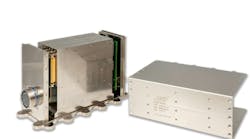The AN/ALE-55 is an RF airborne countermeasure designed to protect the F/A-18E/F Super Hornet carrier-based jet fighter-bomber from radar-guided missiles. BAE Systems began full-rate production of the AN/ALE-55 in late 2011.
The AN/ALE-55 FOTDs and EFCs are components of the integrated defensive electronic counter measures suite. The AN/ALE-55 transmits complex electronic countermeasures signals from a transmitter that trails behind its combat jet to spoof incoming radar-guided anti-aircraft missiles.
The aircraft-towed decoy with onboard electronics works together with the Super Hornet's electronic warfare system to jam radar seekers in air-to-air missiles. The system also can lure incoming missiles away from their actual targets.
The ALE-55 detects a threat radar in its acquisition mode and uses radar jamming to prevent it from locking to a target. The ALE-55's electronic warfare package analyzes the threat, and the towed decoy emits the jamming signals to confuse the incoming missile's tracking radar. If an incoming missile locks on with radar, the ALE-55 analyzes the signal to determine the best jamming technique to break radar lock.
The ALE-55 system consists of an onboard electronic frequency converter and a fiber-optic towed decoy. The EFC converts radio frequency signals sent from the plane’s electronic warfare system into data coded and transmitted via light to the fiber optic towed decoy.
Although the ALE-55 now is in use with the F/A-18E/F Super hornet, it can be adapted to a wide variety of combat aircraft with minimal modifications, BAE Systems officials say.
On this contract BAE Systems will do the work in Nashua, N.H.; Mountain View, Calif.; and Chelmsford, England, and should be finished in November 2015. Awarding the contract were officials of the Naval Air Systems Command at Patuxent River Naval Air Station, Md.
For more information contact BAE Systems Electronic Systems online at www.baesystems.com, or Naval Air Systems Command at www.navair.navy.mil.



